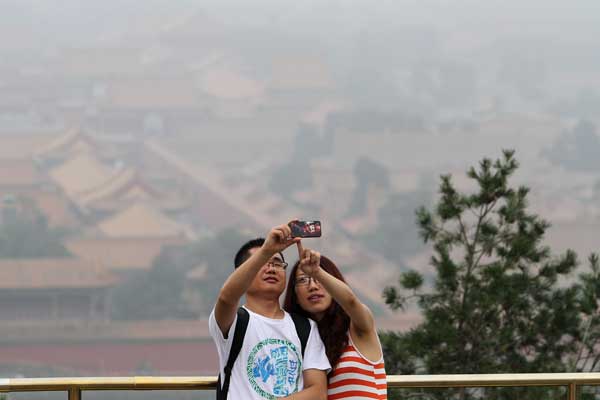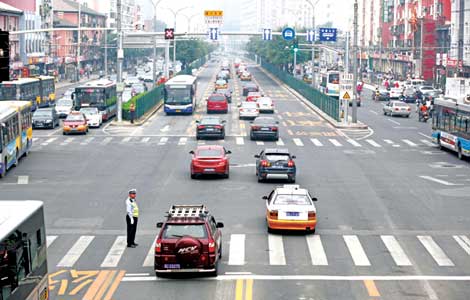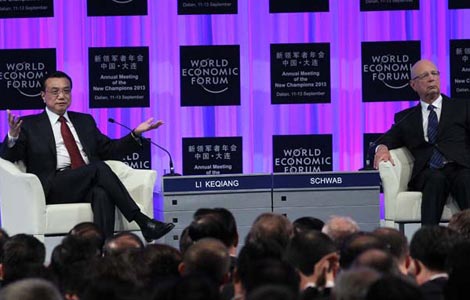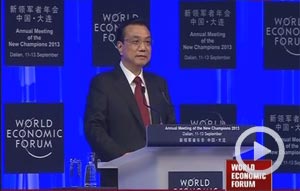China gets tough on air pollution
Updated: 2013-09-13 01:44
By Wu Wencong (China Daily)
|
||||||||
Updated action plan drawn up in response to severe smog at start of the year, Wu Wencong reports
The toughest-ever measures to tackle China's worsening air pollution have been announced by the government.
The Airborne Pollution Prevention and Control Action Plan (2013-17) unveiled on Thursday sets out goals for the nation's 338 cities.
 |
|
A couple in Beijing's Jingshan Park take photos against the background of a smog-shrouded Forbidden City as bad air pollution hit the capital on June 30. ZHUO ENSEN / FOR CHINA DAILY |
The plan aims for a marked improvement in air quality over the next five years, said Wang Jian, deputy head of the Pollution Prevention and Control Department at the Environmental Protection Ministry.
The concentration levels of breathable suspended particles with a diameter of 10 microns — known as PM10 — or less, must fall by at least 10 percent by 2017 from the levels in 2012.
Tougher objectives have been set for some key areas.
For the Beijing-Tianjin-Hebei regional cluster, concentration levels of PM2.5 particles — those smaller than 2.5 microns in diameter, which can penetrate deep into the lungs — must be cut by 25 percent by 2017 from the 2012 level, under the plan.
The target for the Yangtze River Delta region is a reduction of 20 percent and for the Pearl River Delta region it is a cut of about 15 percent.
The plan takes into account pollution and economic development in different areas, with the aim of reducing PM2.5 levels in the three key regions and PM10 levels in the other cities, Wang said.
"But this does not mean that controlling PM2.5 is not important in the other regions, as PM2.5 particles account for 50 to 60 percent of PM10 particles," he added.
The plan is an updated version of one released late last year that was designed to tackle air pollution in 13 key areas.
Under the former plan, PM2.5 levels in the three key areas were targeted to drop by 6 percent by 2015, based on 2010 levels.
Wang said the updated version was drawn up in response to a growing consensus that a tougher approach to air pollution is required following severe pollution in January.
Thick smog and haze covered 2.7 million square kilometers of the country at the start of the year, affecting more than 600 million people.
Shijiazhuang, the capital of Hebei province, saw a record-high hourly concentration level of PM2.5 of more than 1,000 micrograms per cubic meter.
In Beijing, air quality failed the health standard for most of the month.
"The new action plan will bring real improvements to our air quality. Residents will feel the change," pledged Wang.
The action plan, the formulation of which started in December and involved six government departments, contains 35 detailed measures, including bringing pollutants, such as volatile organic compounds, under control. Other measures include achieving negative coal consumption in several regions, accelerating the process of monitoring and disclosing PM2.5 readings, extending monitoring from 119 county-level cities to all 338 before 2015, and banning heavily polluting motor vehicles from the streets by 2017.
Related reading:
Key points of the action plan

 Plenty of fizz
Plenty of fizz
 Traffic about-face seeks to ease congestion
Traffic about-face seeks to ease congestion
 Another iPhone4 explodes while charging
Another iPhone4 explodes while charging
 Premier stresses transformation of the economy
Premier stresses transformation of the economy
 Soyuz capsule returns from space station
Soyuz capsule returns from space station
 China's Christian churches reduce leaders' age ceiling
China's Christian churches reduce leaders' age ceiling
 Student's rare blood bonds Kazakhstan and China
Student's rare blood bonds Kazakhstan and China
 Apple's low-end phone price disappointing
Apple's low-end phone price disappointing
Most Viewed
Editor's Picks

|

|

|

|

|

|
Today's Top News
US moves against China firms criticized
3 sentenced to death for Xinjiang terror attack
Xi welcomes talks on Iran
Assad agrees to hand over chemical weapons
Time of opportunities, challenges
China sets caps for rare earths exploration
Ending non-tariff barriers benefits global economy
Developing nations need shift to balanced growth
US Weekly

|

|






